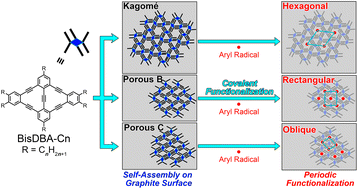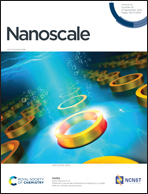Symmetry and spacing controls in periodic covalent functionalization of graphite surfaces templated by self-assembled molecular networks†
Abstract
We herein present the periodic covalent functionalization of graphite surfaces, creating a range of patterns of different symmetries and pitches at the nanoscale. Self-assembled molecular networks (SAMNs) of rhombic-shaped bis(dehydrobenzo[12]annulene) (bisDBA) derivatives having alkyl chain substituents of different lengths were used as templates for covalent grafting of electrochemically generated aryl radicals. Scanning tunneling microscopy (STM) observations at the 1,2,4-trichlorobenzene/graphite interface revealed that these molecules form a variety of networks that contain pores of different shapes and sizes. The covalently functionalized surfaces show hexagonal, oblique, and quasi-rectangular periodicities. This is attributed to the favorable aryl radical addition at the pore(s). We also confirmed the successful transmission of chirality information from the SAMNs to the alignment of the grafted aryls. In one case, the addition of a guest molecule was used to switch the SAMN symmetry and periodicity, leading to a change in the functionalized surface periodicity from oblique to hexagonal in the presence of the guest molecule. This contribution highlights the potential of SAMNs as templates for the controlled formation of nanopatterned carbon materials.



 Please wait while we load your content...
Please wait while we load your content...